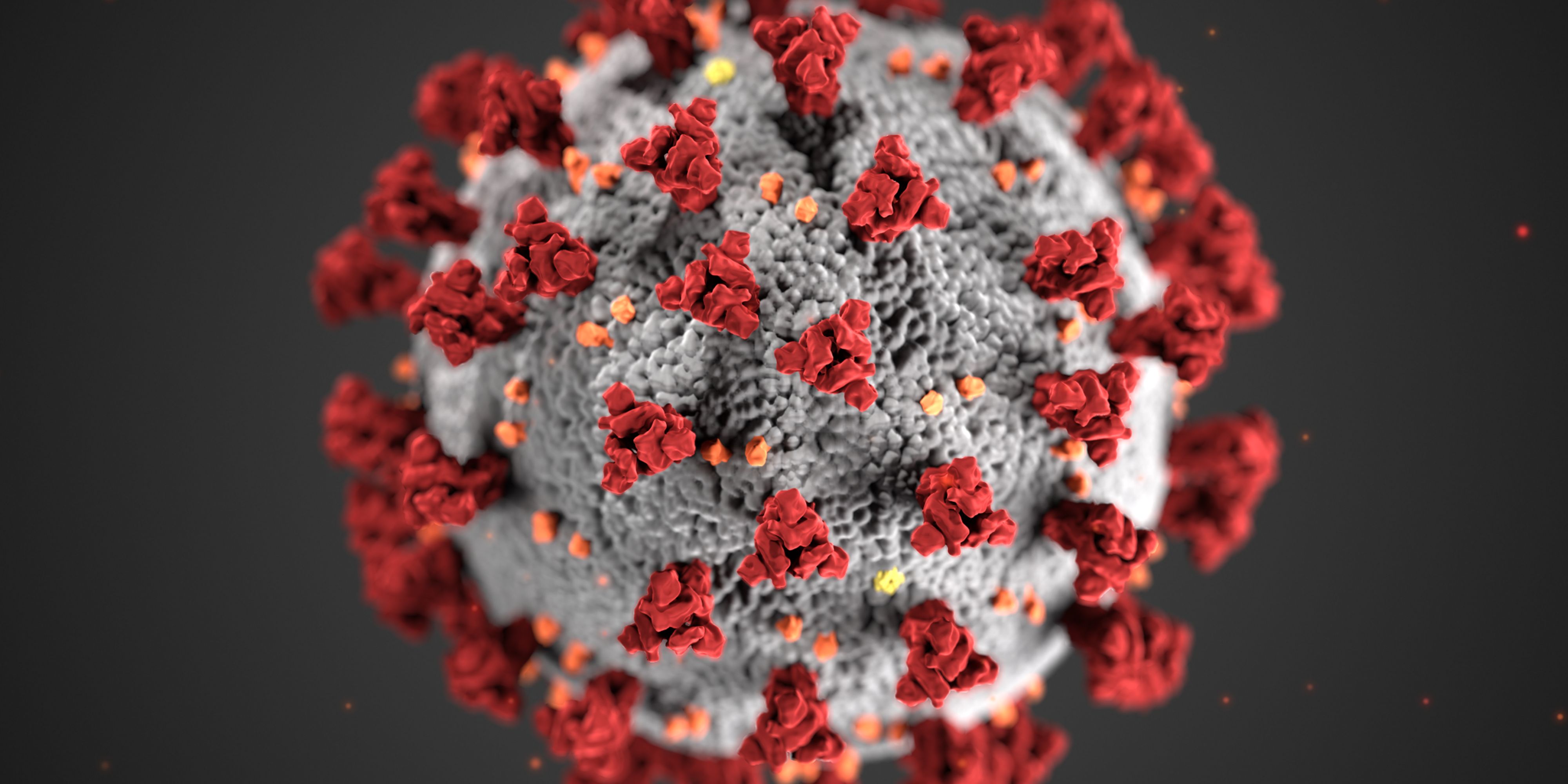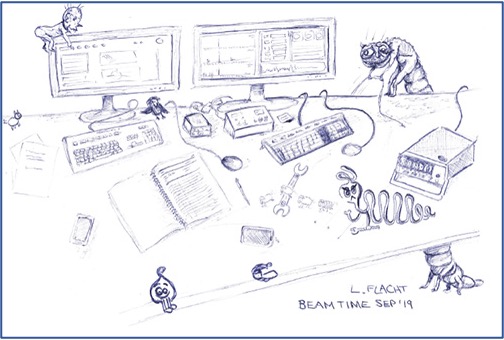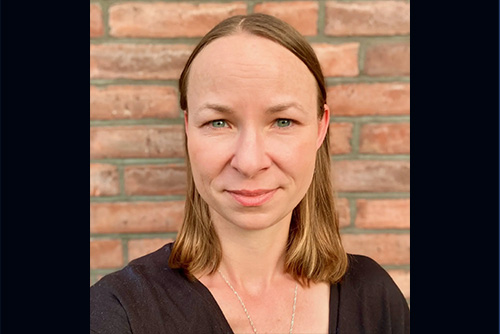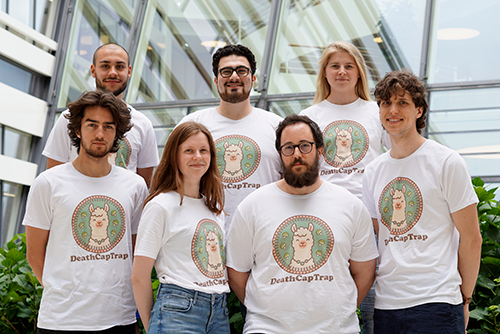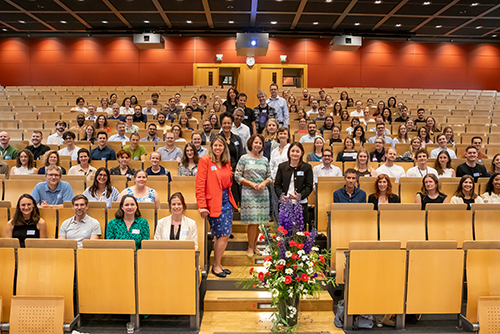Our Research
CSSB scientists are dedicated to investigating how pathogens infect humans however, prior to 2020 none of our scientists were studying the corona virus. CSSB scientists reacted quickly in response to the pandemic and with the support of our five core and multi-user facilities started several new projects investigating SARS-CoV-2. CSSB scientists are currently involved in over ten different projects investigating not only the molecular mechanisms of SARS-CoV-2 but also possible options for prevention or treatment of COVID-19. The news stories below explain some of our recent results:
Multivalent nanobodies block SARS-CoV-2 infection
Scientists identify sybodies to combat COVID-19
Antiviral drug, Favipiravir, could kill SARS-CoV-2 viral genome
Alpaca nanobody neutralizes the SARS-CoV-2 spike protein
Missing link in replication process of coronaviruses identified
CSSB microscopy facilities receive a grant to ensure safe operation during corona pandemic
Publications
Koenig PA, Das H, Liu H, Kümmerer BM, Gohr FN, Jenster LM, Schiffelers LDJ, Tesfamariam YM, Uchima M, Wuerth JD, Gatterdam K, Ruetalo N, Christensen MH, Fandrey CI, Normann S, Tödtmann JMP, Pritzl S, Hanke L, Boos J, Yuan M, Zhu X, Schmid-Burgk JL, Kato H, Schindler M, Wilson IA, Geyer M, Ludwig KU, Hällberg BM, Wu NC, Schmidt FI. (2021) Structure-guided multivalent nanobodies block SARS-CoV-2 infection and suppress mutational escape. 12:eabe6230. doi: 10.1126/science.abe6230.
Custódio TF, Das H, Sheward DJ, Hanke L, Pazicky S, Pieprzyk J, Sorgenfrei M, Schroer M, Gruzinov A, Jeffries C, Graewert M, Svergun D, Dobrev N, Remans K, Seeger MA, McInerney GM, Murrell B, Hällberg MB, Löw C (2020) Selection, biophysical and structural analysis of synthetic nanobodies that effectively neutralize SARS-CoV-2. Nat Commun. 11(1):5588. doi: 10.1038/s41467-020-19204-y.
Hanke L, Vidakovics Perez L, Sheward DJ, Das H, Schulte T, Moliner-Morro A, Corcoran M, Achour A, Karlsson Hedestam GB, Hällberg BM, Murrell B, McInerney GM (2020) An alpaca nanobody neutralizes SARS-CoV-2 by blocking receptor interaction. Nat Commun.11(1):4420. doi: 10.1038/s41467-020-18174-5.
Shannon A, Selisko B, Le NT, Huchting J, Touret F, Piorkowski G, Fattorini V, Ferron F, Decroly E, Meier C, Coutard B, Peersen O, Canard B. (2020) Rapid incorporation of Favipiravir by the fast and permissive viral RNA polymerase complex results in SARS-CoV-2 lethal mutagenesis. Nat Commun. 11(1):4682. doi: 10.1038/s41467-020-18463-z
Wolff G, Limpens RWAL, Zevenhoven-Dobbe JC, Laugks U, Zheng S, de Jong AWM, Koning RI, Agard DA, Grünewald K, Koster AJ, Snijder EJ, Bárcena M. (2020) A molecular pore spans the double membrane of the coronavirus replication organelle. Science. 369(6509):1395-1398. doi: 10.1126/science.abd3629.
Ongoing Projects
Here's a list of our ongoing projects:
High-throughput antibody screening against SARS-CoV2 virus-host interaction utilizing small angle X-ray scattering, electron cryo-microscopy and fast sample delivery.
We aim to determine the specific ways that antibodies bind to the spike protein of SARS-CoV-2 using a new analysis pipeline that joins cryo-electron microscopy of the components and their complexes together with time-resolved small-angle X-ray scattering (SAXS) of solutions as they are mixed together. Using novel fast jet-injection technologies, we aim to find the antibodies with the highest binding affinity to the spike surface protein. We will characterise most specific antibody binding using cryoEM thereby assessing the specific interference in host-cell infection.
CSSB cryo-EM Facility: Dr. Carolin Seuring
CSSB Group Leader: Christian Löw
Collaborators: Prof. Dr. Henry Chapman (CFEL, Center for Free-Electron Laser Science, DESY); Dr. Dmitri Svergun and Dr. Cy Jeffries (European Molecular Biology Laboratory, Hamburg) ; Dr. Kartik Ayyer (Max Planck Institute for the Structure and Dynamics of Matter)
In-solution inhibition studies of SARS-CoV-2 3C-like main protease
As an extension of the crystallographic studies that Alke Meens at al. performed on DESY Campus, Cy Jeffries from the EMBL SAXS group (Dmitri Svergun) performs further extensive in-solution inhibition studies of the SARS-CoV-2 3C-like main protease using SAXS. The required proteins, including the SARS-CoV-2 3C-like main protease, is produced by the PPCF.
CSSB Protein Production facility: Susanne Witt (UKE)
Collaborators: Cy Jeffries (EMBL Hamburg)
Serological test for COVID 19 Description:
Our collaboration partner, the DDM (Diagnostics Development Laboratory) group at the BNI, has a longstanding expertise in the development of ELISA-based serological test being highly specific to distinguish between homologous viral subtypes. For the development of such subtype-specific Sars-Cov2 ELISA-based serological test the PPCF produces a variety of proteins and optimizes their formulation.
CSSB Protein Production facility: Susanne Witt (UKE)
Collaborators: Ben Rushton (DDM, BNITM)
Structure and complex formation of non-structural SARS-CoV-2 proteins
This project aims at studying how the non-structural proteins of SARS-CoV-2 assemble to form the replication complex building on previous work on SARS-CoV using a combination of structural and native mass spectrometry approaches in cooperation with the Bosse lab at CSSB as well as the Rosenthal lab at BNITM. The PC and HTX facilities will support the project with crystallization and further characterization of the proteins.
Scientific Leadership: Charlotte Uetrecht (HPI).
CSSB Group Leaders: Jens Bosse (MHH)
Collaborators: Maria Rosenthal (BNITM)
CSSB PC and HTX facilities: Maria Garcia Alai
Inhibitor screening of SARS-CoV-2 virulence factors
Following interdisciplinary research approaches, we aim to screen and develop effective therapeutics against SARS-CoV-2. To achieve this, groups from CSSB, UHH, FZJ, HZI, DESY and Fraunhoher IME teamed up for the production of SARS-CoV-2 proteins, the high-throughput screening for virulence factor inhibitors using libraries of approved drugs and the structure/function analysis of the enzyme-inhibitor complexes.
CSSB Group Leaders: Michael Kolbe (HZI, UHH) and Jörg Labahn (FZJ)
Collaborators: Johanna Hakanpää (DESY), Björn Windshügel (Fraunhofer IME)
Selection of neutralizing nanobodies against the receptor binding domain of SARS-CoV-2
Neutralizing antibodies/ nanobodies not only bind to the virus but also block infection. Using a large library of synthetic nanobodies, the Loew group aims to generate a binding protein against the receptor binding domain of SARS-CoV-2 which is known to interact with the ACE2 receptor on human host cells. Once nanobodies binding to the piece of the SARS-CoV-2 protein, have been identified, the Hällberg group conducts cryo-EM analysis to find the structural basis for how nanobodies prevent coronavirus from entering cells.
CSSB Group Leaders: Christian Löw (EMBL); Martin Hällberg, (KI)
For more information: https://www.embl.org/news/science/exploring-synthetic-antibodies/
Publications: doi: 10.1126/science.abe6230, doi: 10.1038/s41467-020-19204-y, doi: 10.1038/s41467-020-18174-5
Cellular electron cryo tomography of coronavirus assembly
Our collaborating group at the Leiden University Medical Centre (LUMC) has a long-standing interest in the structural investigation of coronaviruses and their intracellular assembly pathways. Jointly, we apply electron cryo tomography to virus infected cells to understand critical but hitherto less understood steps in coronavirus assembly at the molecular level. Such mechanistic insights are key to identify new target structures for antiviral interventions.
CSSB Group Leader: Kay Grünewald (HPI/UHH)
Collaborators: Montserrat Barcena (LUMC, Leiden, NL)
Publications: doi: 10.1126/science.abd3629
Structural investigations of antibody binding sites on the coronavirus spike protein
Patient serum derived antibodies binding to the SARS-CoV-2 coronavirus spike protein is currently characterized by the group of Thomas Krey (University of Lübeck). Next, we will structurally analyze various antibody-spike protein complexes by single particle electron cryo-microscopy at CSSB. Mapping these binding sites and comparing our results to findings of similar ongoing studies will provide insights on the relative frequency and strength of binding to specific spike protein surface epitopes.
CSSB Group Leader: Kay Grünewald (HPI/UHH)
CSSB Associate Member: Thomas Krey (University of Lübeck)
Collaborator: Thomas Winkler (University of Erlangen)
Multiscale 3D imaging of SARS-CoV-2 live cycle throughout different stages of infection
Following the process of coronavirus infection in 3D from the cellular to the multicellular level is a next level of complexity that is currently rather under-explored. In correlation with fluorescence microscopy information, 3D electron microscopy techniques are now capable of reconstructing very large volumes and hence allow to close this gap. Having access to these techniques developed with the HPI technology platform ‘Microscopy and Image Analysis‘ (Rudolph Reimer) and joining forces with SARS-CoV-2 researchers at HPI and complementary expertise in organoid culture and immunological aspects (likewise at HPI), we are in a unique position to map in 3D the complete SARS-CoV-2 life cycle in a multicellular infection model.
CSSB Group Leaders: Jens Bosse (MHH) and Kay Grünewald (HPI/UHH)
Collaborators: Guelsah Gabriel/ Stephanie Stanelle-Bertram (HPI), Markus Altfeld (HPI), Thomas Dobner (HPI)
Structural analysis of SARS-Cov2 proteins
Viral translation products exhibit typically no functional redundancy which makes any encoded protein a target for intervention aiming for either prevention of infection or reduced viability. We collaborate with external partners in the preparation of corona protein samples for crystallographic analysis targeting subsequent drug ability.
CSSB Group Leader: Jörg Labahn (FZJ)
X-ray based screen of drugs against SARS-CoV-2
The project aims at performing high-throughput X-ray crystallographic screening experiments of several thousand compounds in complex with protein targets at the PETRA III synchrotron, to identify potential drug candidates, which will be subsequently tested in protein activity assays and finally virus cell cultures. The PC and HTX facilities will be used o further characterize drug/target complexes biophysically.
CSSB PC and HTX facilities: Maria Garcia Alai (EMBL)
Scientific Leadership: Alke Meents (DESY)
SARS-CoV-2 RNA polymerase inhibitors
As with other viral infections, the key enzymes of the viral replication are attractive targets to block virus reproduction. SARS-CoV-2 is an RNA-dependent RNA-polymerase that will be addressed by chemically modifying nucleoside analogue triphosphate. Mechanisms of inhibition and structural requirements will be studied e.g. by cryo-EM and X-ray crystallography.
CSSB Scientific Director: Chris Meier (UHH)
Collaborators: Ralf Bartenschlager, Heidelberg; Bruno Canard, Marseille
Inhibition of cellular targets involved in the pyrimidine biosynthesis pathway
For the viral replication high amounts of RNA-nucleoside triphosphates are required. These can be produced by the cellular salvage or the de-novo-pathways. We are aiming for potential small molecule inhibitors that reduce the amount of the pyrimidine nucleoside triphosphates by inhibition of a cellular enzyme involved in the de-novo-pathway and thereby block viral replication. A suitable enzyme has been identified. New small molecules inhibitors will be made and tested. Moreover, structural biology will be done to understand the mechanism of action.
CSSB Scientific Director: Chris Meier (UHH)
Collaborators: EU consortium CARE, H2020
SARS-CoV-2 nsp 3 inhibition by membrane permeable ADPR-analogues
The project aims to modify the functional properties of the non-structural protein nsp3 of the SARS-CoV-2 which is responsible for the removal of adenosine diphosphate-ribose (ADPR) from mono- or poly-ADP-ribosylated proteins (deMARylation/dePARylation enzyme activity). The function of this enzyme seems to be involved in the induction of the cytokine storm observed in severe cases of COVID-19. By inhibition of this enzymatic function it is aimed to prevent this fatal immunologic event.
CSSB Scientific Director: Chris Meier (UHH)
Collaborators: Ralf Fliegert and Susanne Pfefferle, UKE, SFB 1328
